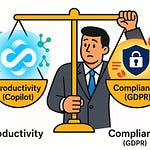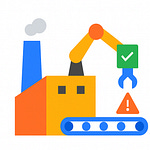Right now, your CRM, ERP, and databases all hold critical insights—but how often do you feel like they’re locked away in silos, impossible to search together? Imagine asking a single chatbot one simple question and instantly getting answers that combine them all. That’s what Microsoft Copilot with Fabric Data Agents makes possible. But how exactly does it unlock cross-system intelligence, and how much work does it actually take to set up? Let’s unpack the process and see what this looks like in the real world of business data.
The Hidden Cost of Scattered Data
Ever feel like you’ve got more dashboards than actual insights? Most companies already swim in reports. Finance has its ERP spreadsheets, marketing builds its own CRM exports, and IT guards a treasure chest of databases that nobody outside of their team seems to understand. On paper it looks like a goldmine of information. In practice it feels more like scattershot fragments that refuse to come together, no matter how much effort anyone throws at them. You can almost hear the groan in the room when someone asks for a “simple combined report” and everyone knows it’ll take weeks.
The issue isn’t that the information doesn’t exist. It’s that every system clings to its own view of the truth like it’s the only source that matters. ERP holds transaction records stretching back years, CRM knows who the sales reps talked to yesterday, and a half-dozen databases store everything from supply chain updates to employee productivity figures. None of them want to talk to each other without a fight. People end up emailing static Excel files around, copying numbers into PowerPoint, and hoping no one notices the lag between what’s presented and what’s actually happening today.
You see it play out in real teams. A sales manager might set targets for the quarter using CRM pipeline data pulled on Monday. On Thursday the finance team is still waiting for ERP to update its reconciliation batch, so revenue looks different depending on which system you check. Marketing jumps in with customer campaign data exported last week, and suddenly the company has three different outlooks on the same quarter’s performance. Decisions get made in that fog, and sometimes they’re flat-out wrong because people were looking at stale numbers without realizing it.
The grind of keeping systems aligned eats into everyone’s day. Someone has to run the export, clean up column headers, merge the files, fix mismatched formats, and upload it all to another system. Then next week the cycle repeats. It’s manual, repetitive work that drains time but still manages to leave gaps. The frustrating part is that workers aren’t spending energy on analysis—they’re spending it on mechanical tasks that software should have solved years ago. Everyone knows the feeling of clicking through endless CSV downloads, watching progress bars crawl across the screen.
If you step back, the cost isn’t just fatigue. Industry surveys often highlight just how much productivity leakage comes from disconnected systems. Hours every week get lost trying to reconcile figures that should already match. Projects stall while teams wait for the right dataset. Leaders hesitate to move because no one has confidence in the numbers in front of them. It isn’t dramatic, but it compounds fast. The lost momentum is invisible on a balance sheet, yet it quietly subtracts from every quarter’s results. By the time a full report comes together, the moment of action has usually passed.
Think about missed opportunities that never even show up on metrics. If frontline managers had quicker, reliable cross-system updates, supply shortages might be spotted before they hit customers. A campaign could be paused before more money is poured into an underperforming channel. Sales reps could approach clients with timely offers rooted in actual revenue positions instead of guesswork. Instead, companies burn time waiting for reports to stabilize while rivals who see faster insights move first. That’s not just a reporting problem—it’s strategy slipping through your fingers.
What makes this grind worse is the assumption that integration is only a plumbing issue, something solved with another data warehouse or another extractor tool. But those solutions often just add another step between users and the answers they need. The reports get bigger, the dashboards fancier, but the delay and disconnect remain. It’s not that people need more exports, it’s that they need walls between systems to stop blocking context. No single department can see the whole picture when every tool forces them to live in its silo.
That’s why the real story here isn’t a shortage of raw material. Businesses already sit on mountains of transactions, interactions, and logs. The challenge is structural. It’s the barriers that keep valuable signals locked in separate rooms. Until those partitions start to come down, more dashboards won’t fix the trust gap—they’ll just layer another view on top of incomplete foundations.
So the real question becomes clear: if the bottleneck isn’t data, but the walls holding it apart, what’s strong enough to break them down and finally make those scattered sources feel like one system instead of ten?
Why Copilot and Fabric Agents Change the Game
Most integration tools love to advertise that they “connect everything,” yet if you’ve ever tried relying on them, you know they always feel halfway finished. It’s as if the wiring is in place, but the lights never quite turn on when you flip the switch. Data gets shoved into one place, sure, but by the time anyone can actually use it, the moment has often passed. That gap between movement and usability is the difference between having a central data repository and having a genuine decision-making tool.
Traditional ETL systems or middleware solutions do play a role—they’re basically the plumbing that carries information from one application over to another. But if you’ve worked with them, you know they’re sluggish when it comes to delivering real-time insight. They dump data into warehouses or lakes, where it sits until you schedule another batch process to refresh it. That might be fine for end-of-month reconciliations or compliance reports, but it breaks down completely when your business needs agility. Asking a live question and waiting hours or even days for the result is no way to drive a sales conversation, adjust an operational forecast, or jump on a customer issue before it escalates.
There’s another frustration that most people encounter—the heavy upfront work. These systems almost seem designed for specialists instead of the staff who actually need answers. You end up with weeks of configuration: mapping fields from one application to another, writing transformation scripts, testing pipelines, tweaking jobs whenever a data schema changes upstream. For IT departments, it’s a constant treadmill. For business users, it’s a waiting game. And in every project, the story looks the same—an IT team sets up an impressive-looking pipeline, celebrates that the integration “works,” and then business users discover they still need to file tickets every time they want a new view.
Imagine a sales director who’s preparing for a Monday board meeting. The IT team has already connected ERP financials to CRM activity, but the director realizes on Friday afternoon she needs breakdowns by product tier in Southeast Asia. With traditional tools, she’s stuck. She can’t build that analysis herself, and with IT juggling other requests, she’s realistically looking at a week or two delay. The meeting happens without those numbers, and another opportunity for precise decision-making slips away. That bottleneck is the real failure of legacy integration solutions—they might move data, but they don’t empower the people who need it most.
This is the exact space where Microsoft Copilot paired with Fabric Data Agents changes the tone. They don’t live off in some special-purpose tool that you deploy only for reporting. They’re woven directly into the broader Microsoft 365 applications that most staff already log into every day. That makes them feel less like an outsider addition and more like a natural extension of the work environment people are accustomed to. Instead of clicking through custom dashboards or struggling with query languages they’ve never learned, users can interact conversationally with what amounts to an AI-powered colleague who already understands the company’s connected data sources.
The technical shift here is subtle but powerful. You’re no longer forced to rely on bespoke scripts or elaborate middleware. Fabric Data Agents have knowledge of connectors baked in. Think of them as AI assistants that already understand both how to pull the data and how to structure it in a way that business logic requires. Rather than needing your IT staff to handcraft every query, the system interprets natural questions and generates the data actions beneath the surface. Ask, “Show me revenue trends from high-value clients in the last quarter,” and Copilot translates that into the appropriate queries, fetching combined insight from both CRM and ERP datasets.
That translation layer is what removes so much friction. You don’t have to learn SQL if you’re in finance, or dig into API documentation if you’re in sales. The AI sits in between, taking the language you use day-to-day and converting it into the structured requests your systems demand. The turnaround time shifts from “submit a report request and wait weeks” to simply “ask and answer.” Not only faster, but also far closer to how humans naturally think about questions in business contexts.
So instead of just being another integration tool, this combination of Fabric and Copilot pushes the model to a different dimension. The interaction is conversational, not mechanical. The outputs are instantly usable, not delayed batches. And perhaps most importantly, the access isn’t gated by technical skill. Everyone in the organization can suddenly act as though they have a data engineer sitting at their desk full-time. It removes the sense of complexity that’s haunted integration projects for years and replaces it with something much more approachable.
But none of that would even be possible without one underlying factor. This conversational simplicity relies entirely on how well those connectors actually pull and unify information from dozens of different systems. That’s where the backbone of the approach comes into focus, and it’s what we need to explore next.
The Power of Fabric Connectors
How does all your scattered data—from SAP, Dynamics, and SQL—suddenly become searchable as if it were part of one system? The secret here isn’t some massive custom integration project or an army of developers working nights and weekends. The backbone is something much more standardized: Fabric Connectors. These prebuilt components already understand how to talk to the most common business systems, and that changes the economics of integration entirely.
If you’ve ever been involved with connecting a major ERP to a CRM, you already know the pain. Each system not only holds its own data model but also carries its own quirks, authentication methods, and APIs that evolve over time. Traditionally, to bridge those worlds, engineers build what feels like a house of cards: extract, transform, load jobs scheduled at intervals, along with middleware designed to smooth over mismatched data. That work rarely takes days—it normally stretches into weeks or months. And every time the vendor updates their product, the integration code often breaks, forcing another cycle of patches and testing.
Take a concrete example. Imagine linking SAP ERP with Salesforce CRM. These two systems speak completely different technical languages. SAP exposes its financial and operations data in one format, while Salesforce structures leads, opportunities, and customer interactions another way. To make them share a common story, companies usually hire consultants or invest in middleware stacks. Even then, the result is often brittle: revenue figures in SAP don’t always line up with the sales pipeline in Salesforce, and someone ends up manually patching errors downstream. By the time it all works, the business landscape has already shifted again.
Fabric Connectors flip this around. Think of them as prebuilt bridges that already know both dialects. Instead of hiring someone to code translation logic line by line, the connectors arrive with an understanding of how to authenticate, map key fields, and handle data structures within each supported system. When you choose a Dynamics 365 connector, for example, it’s not starting from zero—it already knows how tables inside Dynamics relate, and how to bring them into a unified Fabric environment. The same goes for SQL Server, Oracle, SAP, Salesforce, and dozens of other common platforms.
Picture a diagram where boxes containing each system float apart on one side, and connectors extend out like bridges that all land on the Fabric platform. Visually, that shows the trick: rather than every system trying to talk directly with every other, they all meet in the same place. That central hub becomes what your Copilot can query. The complexity of the point-to-point integration is completely hidden from the user, because the connector already packaged it up out of the box.
Researching the catalog of available connectors, you find support for the systems most companies rely on as their core stack: Microsoft’s own Dynamics apps, Azure SQL, SharePoint, SAP ERP, Salesforce, Oracle databases, and even less glamorous sources like file shares or cloud storage accounts. That range matters because few organizations run only one platform. Most live with a mix of cloud and on-premises solutions accumulated over decades, and Fabric Connectors are designed specifically to handle that messy reality without reinventing the wheel each time.
Here’s the real twist. With these connectors, users don’t need to understand SQL joins, stored procedures, or REST APIs. All of that technical translation—normally the hardest part—has already been wrapped into the connector itself. Instead of an analyst writing queries or juggling authentication tokens, they select the source, configure security permissions, and Fabric does the rest. It shifts the heavy lifting from custom engineering into a setup task that feels more like assigning permissions than coding an application.
That change has practical consequences. When a company wants to connect a new CRM instance or pull in supply chain data from SAP, the timeline is no longer a multi-month roadblock involving consultants and testing cycles. Instead, it becomes a matter of choosing the right connector, authenticating with credentials, and validating that the dataset flows properly. Hours instead of months. That reduces the barrier so dramatically that businesses can think about integrating data sources that once felt too costly to bother with.
So what happens once these connectors do their work and all that scattered data finally lands in one searchable landscape? That’s when the fun actually begins. Because only after the raw plumbing is handled can you turn loose a conversational AI to explore it. Instead of guessing where to look or submitting tickets for IT to build custom reports, you can simply ask the chatbot a straight business question and get back an integrated answer immediately.
In other words, connectors transform integration from an endless drain on engineering bandwidth into a configuration task that any skilled admin can manage. The payoff is that the AI-layer—Copilot—has reliable access to unified datasets without teams fighting over exports and file merges. With the plumbing simplified, the stage is set for the real star: building a chatbot that employees across the business can query directly. And that’s what we dive into next.
Building Your First AI Data Chatbot
Imagine sitting down at your desk, typing a question as plain as “What were last quarter’s top products in Europe?” and within seconds getting back an answer—not from a report you begged IT to build, not from a spreadsheet you patched together, but from a chatbot that already understands where to look. That visual alone captures the real reason people get excited about these tools. It’s not just integration working in the background. It’s the fact that the work finally shows up where decisions happen: in an interactive, conversational interface.
The shift really comes into focus when you think about how chatbot projects traditionally go. In the past, anyone who wanted a bot to answer company-specific questions had to invest in natural language processing models, custom connectors, and a lot of engineering. Most of those projects turned into long R&D experiments where developers spent more time building pipelines than users ever spent asking questions. By the time the pilot bot worked, business leaders had already moved on to other priorities. It felt like a tool always in the process of being finished, never in the process of being useful.
Now picture a different outcome. A mid-sized manufacturer decides they want one place where sales reps, finance staff, and operations managers can all query core performance data. They spin up an internal bot powered by Copilot and Fabric Agents. Instead of handcrafting model training, they simply link Fabric Connectors to the ERP, CRM, and inventory systems. Users ask in plain English, and the AI stitches the relevant data together on demand. Suddenly, the CFO can ask about margins while the sales lead drills into pipeline conversion, all in the same environment, without waiting for anyone to code a new report.
How does this actually get off the ground? Step one is connecting the right data sources. Using the Fabric environment, you authenticate against your ERP system, bring in your CRM records through its connector, and link whatever SQL or file-based data sources hold supporting context. The heavy lifting is inside the connector setup, which already understands formats and login methods. Step two is enabling Copilot with Fabric Data Agents. At this stage, you’re not custom coding—you’re basically telling the system which datasets should feed into conversational queries. Once that’s complete, you have what looks less like a “bot project” and more like turning on an extension to a tool you already use.
What makes it feel natural is the way Copilot interprets queries. You don’t have to write SELECT statements or map joins manually. You type what you want answered, and under the hood it generates the structured requests that normally only analysts could write. That’s what gives the interface its flexibility: you’re no longer locked to a dashboard designed six weeks ago, you’re asking fresh questions in the moment and letting AI do the translation between human intent and database structure.
Visualize this in practice. A finance team member types, “Show me overdue invoices from the last 30 days.” Within seconds, not only do they get a clear result, but an existing Power BI dashboard updates with that filtered view. There’s no chain of emails, no CSV exports saved to the desktop. It’s direct interaction with the data, mediated by AI. That kind of speed has a multiplying effect, because once one department starts relying on it, others quickly realize they can do the same for their own daily questions.
The bigger takeaway is what happens when everyone in the company gains this access. If frontline staff, leadership, and even back-office teams can all query cross-system data whenever they need it, patterns that were invisible start emerging. Employees don’t have to filter requests through a central IT bottleneck anymore. Insight becomes part of the daily conversation, not a quarterly ritual. You start getting questions from people who never would have asked before, simply because the friction to find answers has dropped away.
That’s the quiet revolution here. Spinning up a chatbot that speaks across ERP, CRM, and databases is now easier than curating another complex dashboard or standing up a new warehouse. The technical barrier falls so far that the hardest part is no longer integration—it’s figuring out which questions you want to prioritize first. And once that foundation is in place, the conversation turns quickly from “Can we connect this data?” to something much more forward-looking: what unexpected insights can this kind of system bring to light? Because the real magic begins when you stop asking for past numbers and start recognizing the predictions these tools can generate.
Real-Time Insights and Predictions
What if instead of waiting on last quarter’s numbers, you could see the direction of the next one before it even begins? Reports tell you what already happened, but once your data sits in a unified environment, those same numbers can drive something far more useful: predictive models that forecast what’s likely to happen next. And that’s where the story shifts from static metrics into a tool for making smarter moves in real time.
The reality is, most companies still run on backward-looking KPIs. You check revenue after the quarter closes, inventory once it’s already missing, and customer churn after the contracts are lost. By the time those figures surface, the damage has already occurred. It’s not that leaders don’t want to be proactive—it’s that their systems only show them the past. And that disconnect undersells what enterprise data is capable of doing when it’s connected and accessible in a way that AI can draw on.
One of the clearest illustrations shows up in supply chain management. Imagine a logistics manager responsible for several distribution hubs. In the traditional setup, shortages appear in ERP data once orders are late and warehouses start flagging errors. But with AI-driven predictions built on integrated data, that same manager can get an alert days in advance that a particular supplier is trending toward delay. Copilot can scan sales velocity from CRM, inventory balances in ERP, and vendor delivery times pulled from operations databases, then flag where the risk appears. Instead of reacting to missing shipments, procurement teams negotiate alternatives before customer demand even notices the gap. That kind of anticipatory signal can be the difference between maintaining service levels and scrambling to patch a problem after the fact.
It’s not only supply chains that benefit. Think about sales forecasting. Traditionally, pipeline health is summarized into a chart once or twice a quarter. But when AI has access across CRM opportunity data, historical customer win rates, and even macro-level purchasing patterns, it can start showing which segments of the pipeline are most likely to close weeks down the line. A sales leader doesn’t just see what has already closed, they see which deals are shaping up to be critical before the quarter-end rush. Marketing can then shift campaigns to boost those specific deals rather than waiting for post-mortem reports on what failed.
What makes these predictions so powerful is that no single system on its own could uncover them. CRM can tell you activities logged by reps, but not the supplier delays that might impact delivery confidence. ERP knows the cost side of the equation, but not the customer lifetime value trends shaping renewal decisions. It’s only when you have integrated datasets that patterns emerge—trends that fall between the cracks when each department stays isolated. AI draws strength from that combined view, surfacing signals a human user would rarely have the time or access to calculate on their own.
The value to managers is obvious. Instead of looking at historic snapshots, they see live metrics enhanced with probabilities and directional indicators. A dashboard no longer just shows, “Inventory: 6,000 units,” it shows, “Inventory will fall below safety stock in ten days if sales velocity continues at the current pace.” That change transforms time horizons. People can shift resources earlier, allocate budgets smarter, and reduce the margin of error before problems grow large enough to show on a standard report.
In industry after industry, case studies point to the same result: when predictive AI enters workflows, decision-making improves. Retailers avoid stockouts and overstocks. Manufacturers spot maintenance needs before equipment failures shut down production. Service providers can anticipate churn risk and target customer retention activities with far better precision. These aren’t replacement processes—they’re enhancements to the existing systems, adding foresight to environments that were once locked into hindsight. It’s essentially moving the focus from explaining what happened to preparing for what is about to.
And here’s the strategic layer to think about. If every team in a business can forecast trouble or opportunity sooner, strategy itself speeds up. It stops being a plan adjusted once a year based on history, and it becomes a dynamic process that reacts as conditions shift. Competitors relying on static KPIs inevitably play catch-up, while those using predictive insights execute ahead of the curve. At that scale, forecasts aren’t just handy—they become a differentiator that impacts margin, customer satisfaction, and market positioning.
In the end, this is why data integration tied to AI feels far more than an efficiency upgrade. It doesn’t just give companies one place to see their answers. It turns the archive of transactions into a tool projecting forward, a set of early signals that reshape how people think about time. Past-focused reporting is an anchor. Predictive insights are a sail. And when those systems are available to any staff member through natural language queries, access to foresight stops being a specialist function—it becomes part of the everyday workflow. So as leaders, the real choice isn’t whether to use it. It’s how quickly you’re prepared to make it part of your normal decision-making rhythm.
Conclusion
The real shift here isn’t about having access to endless reports—it’s about making future-focused decisions that anyone can query in plain language. When every employee can ask a question and trust the data behind the answer, decision-making changes from reactive to proactive.
If you want to see it in action, start small. Connect your top two data sources with Fabric and try Copilot for yourself. The difference between exporting spreadsheets and asking questions directly is immediate. When silos disappear, choices get sharper, speed increases, and foresight finally becomes part of everyday business decision-making.











